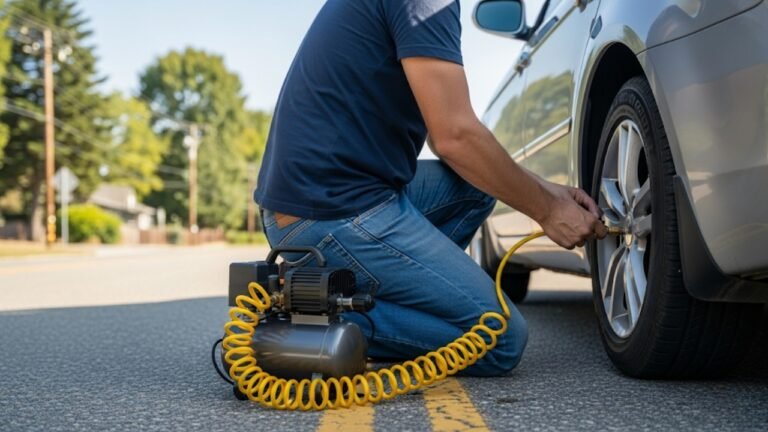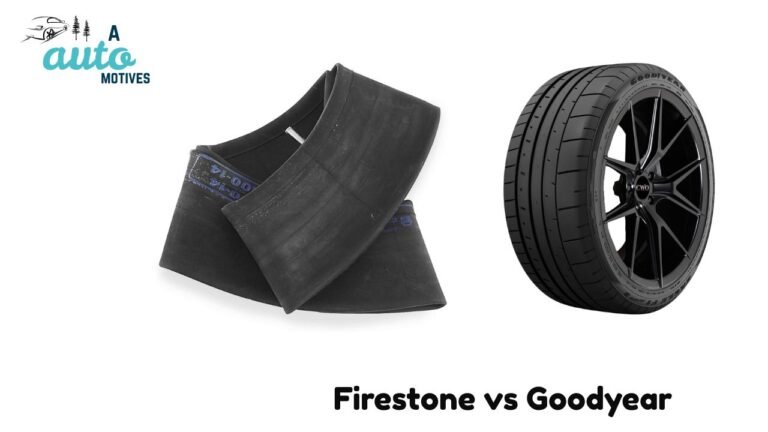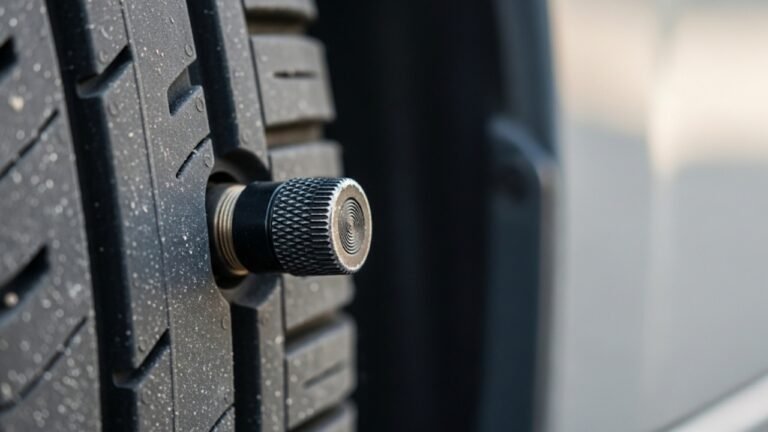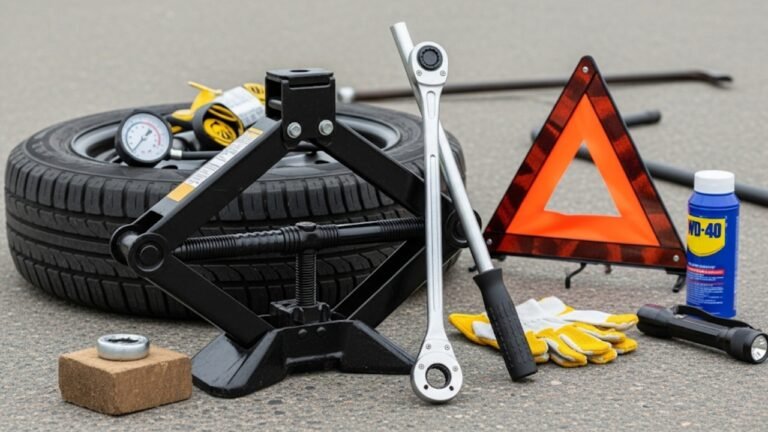How Fast Can You Drive on a Donut Tire?

Let me set the scene. I was cruising down the highway, music blasting, coffee in hand, feeling like I had the day under control. Suddenly, I felt the dreaded thump-thump-thump and the steering wheel started pulling to the side. Flat tire. Just like that, my perfect morning turned into a roadside hassle.
I popped the trunk, pulled out my donut tire, and installed it with a sigh. Now, here’s the million-dollar question I kept asking myself: How fast can you drive on a donut tire?
If you’ve ever been in this situation, you’re not alone. Thousands of drivers each day slap on a temporary spare tire—aka “donut”—without really knowing the limits. This guide will walk you through everything you need to know about driving on a donut safely, how fast you can go, and what dangers to avoid. Grab a coffee and let’s talk like friends because this is real-life stuff we all deal with.
What Is a Donut Tire and Why Is It Different?
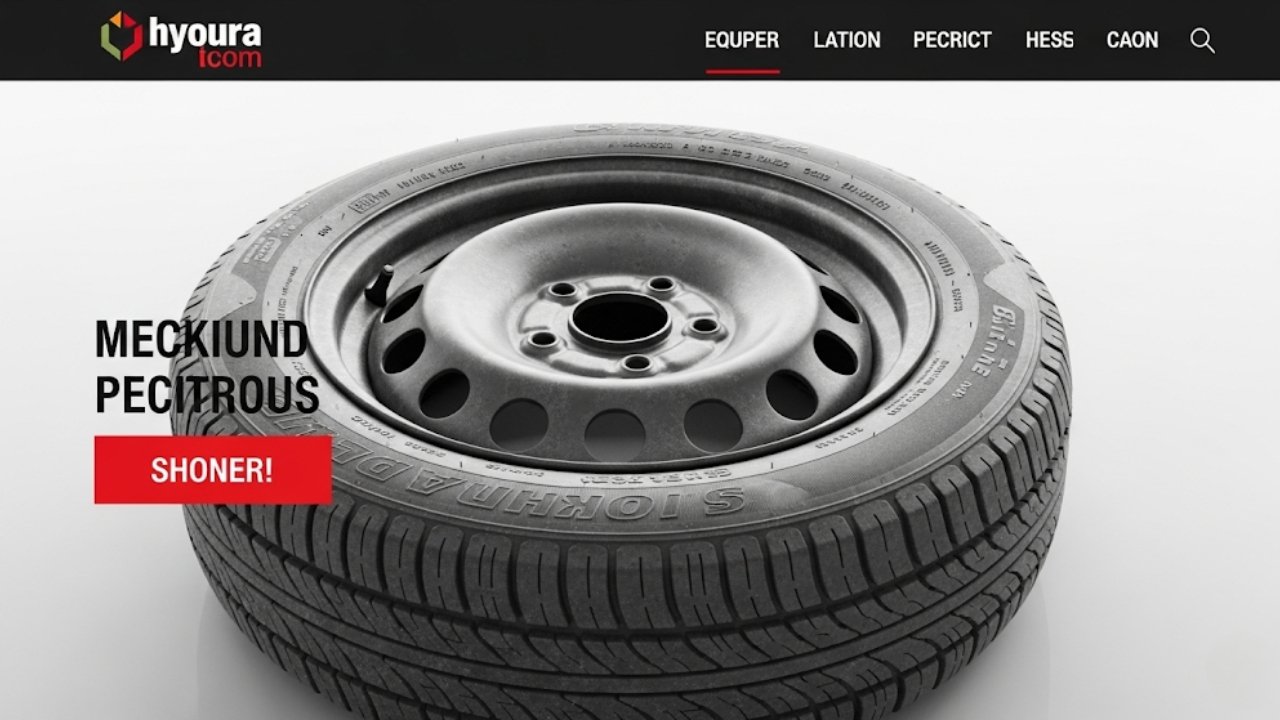
Let me break it down:
| Feature | Donut Tire | Regular Tire |
|---|---|---|
| Size | Smaller, thinner | Full-sized |
| Lifespan | Up to 70 miles | 30,000–60,000 miles |
| Speed Limit | 50 mph max | Varies (Up to 100+ mph) |
| Purpose | Temporary, emergency use only | Daily driving |
| Handling | Reduced grip and stability | Designed for safety and comfort |
So if you’re wondering how fast can you drive on a donut tire, here’s the official answer from most tire manufacturers: 50 mph (80 km/h) tops. But more on that in the next section.
How Fast Can You Drive on a Donut Tire? The Honest Truth
Let’s get to the heart of it. You should not drive faster than 50 mph (80 km/h) on a donut tire. And honestly, even that can feel a bit sketchy, especially if you’re on the freeway surrounded by 18-wheelers zooming past.
I remember once pushing it to 60 mph just to keep up with traffic—and my steering felt like I was on a balance beam with a bowling ball in each hand. Not fun.
Why the Speed Limit?
-
Structural limitations: Donuts are built for short trips, not high performance.
-
Reduced tread: Less grip on the road means more risk at high speeds.
-
Less stability: The smaller size messes with your vehicle’s balance.
-
Brake imbalance: Different tire sizes cause uneven braking, especially dangerous at higher speeds.
Driving above the recommended speed can lead to overheating, blowouts, or worse—complete tire failure.
Let’s be real—just because you can push it a little doesn’t mean you should.
How Long Can You Drive on a Donut Tire? (Spoiler: Not Long)
While the main question is how fast can you drive on a donut tire, the next thing you should worry about is how far.
Most donut tires are built for 50 to 70 miles, tops. After that, the rubber starts wearing down fast, and the risks pile up.
Think of it this way: driving on a donut is like walking on a sprained ankle. Sure, you can hobble along, but you wouldn’t want to hike a mountain.
Real Talk from the Road:
-
I once drove 45 miles on a donut trying to find a tire shop that was actually open. It was nerve-racking. Every bump made me wonder if the tire would give out.
-
If you absolutely have to drive farther, go slow, avoid highways, and take frequent breaks to check the tire.
Remember, it’s temporary—like duct-taping your bumper. It works for now, but you wouldn’t leave it like that forever, right?
Why Speeding on a Donut Tire is a Recipe for Disaster
You’re late for work. You’re tempted to cruise at 65 mph. But let’s pause here.
Driving too fast on a donut tire can cause serious problems. Let’s look at a few dangers that come from pushing the limits:
-
Blowouts: These little tires can’t take the heat or pressure from highway speeds.
-
Poor braking: Your car may pull to one side or take longer to stop.
-
Traction loss: Especially on wet or uneven roads, donuts offer less grip.
-
Suspension strain: Uneven tire sizes throw off alignment and suspension.
Donut tires are not just “smaller tires”—they’re backup dancers, not the stars of the show. And pushing them too far is like asking the intern to run the whole office.
Tips to Safely Drive on a Donut Tire
So, you’ve had to install a donut tire. No biggie. Just drive smart. Here are some quick safety tips to make sure you get home—or to the tire shop—in one piece:
-
Stick to 50 mph or less
-
Drive only 50–70 miles maximum
-
Avoid highways if possible
-
Check your tire pressure—donuts often sit in your trunk for years and lose air
-
Drive cautiously—turns, stops, and acceleration feel different
-
Fix your full tire ASAP
Here’s a tip I learned the hard way: donut tires need 32–60 psi pressure depending on the type. Always check the label on the tire or inside your trunk lid.
Why You Should Replace a Donut ASAP
Let’s be honest. Life gets busy. You say, “I’ll fix it tomorrow,” and then three weeks later, you’re still driving on a donut.
Don’t be that person. Seriously.
Driving too long on a temporary tire puts you, your passengers, and other drivers at risk.
Here’s what can go wrong:
-
Your suspension wears unevenly
-
Your transmission gets stressed
-
You burn more gas
-
You risk a dangerous blowout
Plus, some insurance companies may not cover damage caused by prolonged donut use if you ignored warnings.
Can You Drive on a Donut Tire in the Rain?
Now here’s a scary but very real situation—you’re stuck on a donut, and it starts pouring. What do you do? Can a donut tire even handle wet roads?
Here’s the hard truth: driving in the rain with a donut tire is dangerous. These tires are designed with minimal tread. That means less grip. And on wet, oily roads? Your chances of hydroplaning shoot up.
When I had to drive through a sudden downpour in my old Corolla with a donut on, I swear every red light felt like Russian roulette. My car would slide just a little more than it should, even under light braking.
Tips for Wet Weather:
-
Drive 30–40 mph max
-
Double your braking distance
-
Avoid puddles and sharp turns
-
Don’t tailgate—leave a huge buffer
-
Use headlights and hazard lights if needed
If rain hits hard, try to pull over somewhere safe until it passes. It’s better to be 30 minutes late than end up skidding into traffic.
How Does a Donut Affect Your Braking and Steering?
Let’s talk mechanics. Your car is designed to run on four tires of the same size and type. Pop a donut on there, and you change the entire balance of the system.
Here’s how your car reacts:
-
Braking: Uneven weight distribution means the donut side may brake slower or cause the car to veer.
-
Steering: Your wheel may feel lighter or heavier on one side. This can cause understeering or oversteering, especially at curves.
-
Suspension & Alignment: Long use messes up your alignment and puts strain on joints.
I noticed my car pulling slightly to the right even when driving straight—just from using the donut. Not dangerous for short trips, but definitely noticeable.
Metaphor time:
Imagine walking with one shoe and one slipper. Sure, you can walk. But can you jog? Can you dance? Nope. Your balance is off. That’s how your car feels with a donut.
Real Stories: What Happens When You Push a Donut Too Far
Nothing teaches better than real-life experience. So let’s look at a few cautionary tales that show what can go wrong when you ignore the donut tire rules.
Case 1: Highway Blowout
A friend of mine once kept a donut on his Honda for a week. He was commuting 40 miles daily and got used to it. One day, he pushed it to 65 mph on the highway. The result? The donut overheated, sidewall cracked, and the tire blew out. He lost control and spun out—luckily, no one was hurt.
Case 2: Suspension Damage
Another buddy ignored the “replace within 70 miles” rule. Two weeks later, his steering started feeling weird. Turns out, the uneven tire stress had worn down his front struts. The $80 tire fix turned into a $600 suspension repair.
So yes, the consequences are real. It’s not just “playing it by ear”—it’s a real risk to your life and wallet.
Donut Tires vs. Full-Size Spares: Know the Difference
Some people confuse a donut tire with a full-size spare. Let’s clear that up.
| Feature | Donut Tire | Full-Size Spare |
|---|---|---|
| Size | Smaller, thinner | Same as regular tire |
| Distance Limit | 50–70 miles | No limit (normal use) |
| Speed Limit | Max 50 mph | Same as other tires |
| Handling Impact | High | Minimal |
| Replacement Urgency | Immediate | Can wait if matched tire |
So, if you’re driving on a donut tire, don’t assume you can treat it like a regular spare. It’s not built for distance, speed, or regular driving.
Cost of Fixing a Flat vs. Driving Too Long on a Donut
Here’s where things get interesting—and expensive. Many people drive too long on a donut to save money. But what’s the real cost?
Short-Term Fix:
-
Tire patch or plug: $15–$30
-
New tire: $80–$200
Long-Term Damage (from overusing a donut):
-
Alignment repair: $100–$150
-
Suspension repair: $400–$800
-
New wheel if damaged: $150–$400
-
Accident damage: $$$$
It’s like trying to save on toothpaste by skipping brushing—it just leads to bigger dentist bills later.
Expert Tips to Handle a Donut Like a Pro
Let’s wrap up with some pro tips to make sure you’re never caught off-guard:
-
Check your spare tire pressure every 3 months
(They lose air just sitting in the trunk) -
Practice changing a tire at home once
(Nothing’s worse than learning in the rain) -
Get a full-size spare if you road-trip often
-
Always keep a portable air compressor in your trunk
-
Know the donut speed & mileage limits by heart
Frequently Asked Questions (FAQs)
1. How fast can you drive on a donut tire?
You should never drive faster than 50 mph (80 km/h). Pushing beyond that increases the risk of tire failure.
2. How far can I drive on a donut tire?
Most manufacturers recommend no more than 70 miles. Replace or repair your full tire as soon as possible.
3. Can I drive on a donut in the rain or snow?
You can, but it’s not ideal. Traction is poor, so drive slowly, and avoid risky conditions if possible.
4. Is it safe to drive on the highway with a donut tire?
No. Highway speeds are too fast for donuts. Stick to side roads until you get your full tire fixed.
5. Can I use a donut tire on the front of my car?
You can, but it may affect steering and braking more than if it’s on the rear. If possible, swap with a rear tire.
6. How do I know if my spare is a donut or full-size?
Check the size stamped on the tire. Donuts are usually much smaller and labeled “Temporary Use Only.”
7. Will using a donut mess up my car?
If used briefly and correctly, no. But extended use can harm your suspension, alignment, and even transmission.
8. What’s the pressure for a donut tire?
Usually 60 psi, but check your specific vehicle label or donut sidewall. Keep it inflated!
Final Thoughts: Respect the Donut, Respect the Road
Driving on a donut tire is like running on borrowed time. It gets the job done, but only for a short while. You wouldn’t wear flip-flops on a hike, right? Same logic.
So if you’re wondering how fast can you drive on a donut tire, remember: stick to 50 mph, keep it under 70 miles, and get it fixed fast. The donut isn’t your backup plan forever—it’s just a way to get home safe.
Let’s treat it with respect, and we’ll all get where we’re going, one safe mile at a time.



